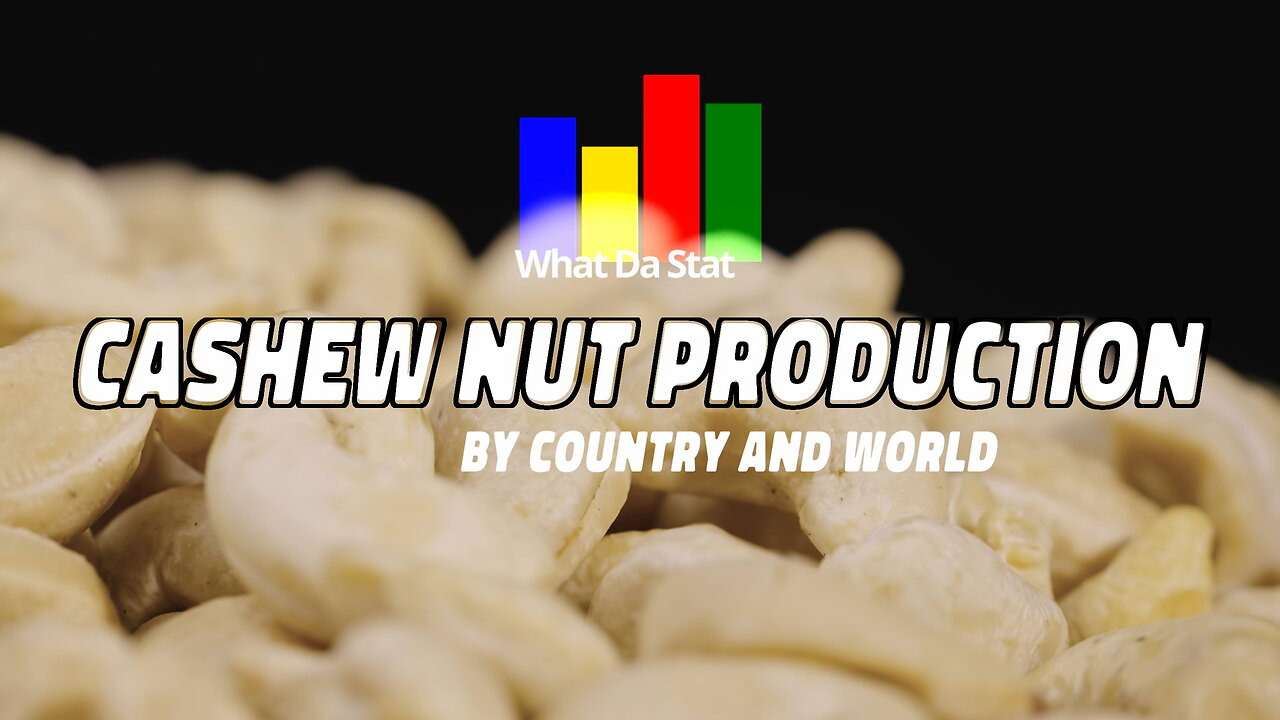Premium Only Content

Cashew Nuts Production by Country and World since 1961
This bar chart race shows cashew nuts production by country and world since 1961, measured in metric tonnes.
Cashew nut production has witnessed remarkable growth since 1961, evolving into a major global industry. The journey of cashew nuts, scientifically known as Anacardium occidentale, has been marked by shifts in production patterns, geographical expansions, and socioeconomic implications.
In the early 1960s, cashew production was concentrated in a few tropical countries, primarily in South America, Africa, and Asia. Over the decades, there has been a notable shift in the global distribution of cashew cultivation. While Brazil, Nigeria, India, and Tanzania were among the early players, countries like Vietnam, Ivory Coast, and Indonesia have emerged as key contributors in recent years.
Several factors have fueled this expansion. The adaptability of cashew trees to diverse climates, coupled with their resilience to harsh conditions, has encouraged cultivation in a broader range of regions. Additionally, the growing demand for cashew nuts in international markets, driven by their nutritional value and versatile applications, has incentivized farmers to increase production.
The processing of cashew nuts has also undergone significant changes. Traditionally, processing involved manual labor, but technological advancements have introduced mechanized methods, improving efficiency and output. This shift has not only boosted productivity but has also impacted employment patterns in the industry.
The socioeconomic impact of cashew production is noteworthy. Many cashew-producing regions, especially in sub-Saharan Africa and Southeast Asia, have experienced improved economic conditions due to the cashew industry. The cultivation of cashews has become a vital source of income for smallholder farmers, contributing to poverty alleviation and rural development.
Despite these positive trends, challenges persist. The industry is vulnerable to price fluctuations influenced by global market dynamics. Issues such as pests and diseases also pose threats to cashew production. Sustainable practices and initiatives aimed at addressing these challenges have gained traction, emphasizing the need for a balanced approach to ensure the long-term viability of the cashew industry.
In conclusion, the global cashew nut production landscape has transformed significantly since 1961. From its concentrated origins to a widespread, economically impactful industry, cashew cultivation has evolved with changing times. The challenges faced by the sector underscore the importance of sustainable practices and international cooperation to secure the future of this versatile and economically significant nut.
Data source: FAO
Data visualization created with flourish.studio
-
 DVR
DVR
Bannons War Room
10 days agoWarRoom Live
2.67M446 -
 16:06
16:06
The Rubin Report
15 hours agoProof the Islamist Threat in England Can No Longer Be Ignored | Winston Marshall
96.3K85 -
 2:07:07
2:07:07
Robert Gouveia
12 hours agoFBI Files Coverup! Bondi FURIOUS; SCOTUS Stops Judge; Special Counsel; FBI Does
122K90 -
 56:15
56:15
Candace Show Podcast
13 hours agoBREAKING: My FIRST Prison Phone Call With Harvey Weinstein | Candace Ep 153
177K116 -
 1:56:39
1:56:39
Flyover Conservatives
11 hours agoROBIN D. BULLOCK | Prophetic Warning: 2030 Is Up for Grabs – If We Don’t Act Now, Disaster Awaits! | FOC SHOW
63.7K14 -
 2:13:11
2:13:11
megimu32
9 hours agoON THE SUBJECT: The Epstein List & Disney Channel Original Movies Nostalgia!!
48.7K6 -
 9:06
9:06
Colion Noir
18 hours agoKid With Gun Shoots & Kills 2 Armed Robbers During Home Invasion
59.7K14 -
 54:28
54:28
LFA TV
1 day agoUnjust Man | TRUMPET DAILY 2.27.25 7PM
60.6K5 -
 1:36:39
1:36:39
Redacted News
13 hours agoBOMBSHELL EPSTEIN SH*T SHOW JUST DROPPED ON WASHINGTON, WHAT IS THIS? | Redacted w Clayton Morris
186K311 -
 2:03:31
2:03:31
Revenge of the Cis
14 hours agoEpisode 1453: Fat & Fit
69.1K9